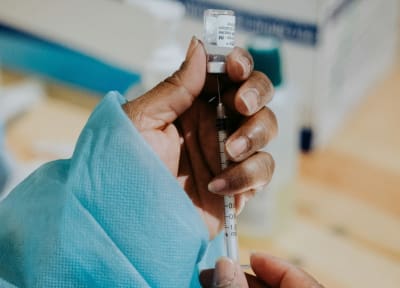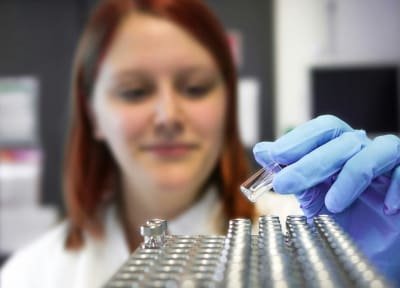Newborn and Childhood Vaccines
Learn about how vaccines keep children healthy and protected.
On This Page:
Overview
Vaccines prevent infectious diseases that once killed or harmed many infants, children, and adults. Vaccines also protect children from serious harm or lifelong side-effects these diseases may cause. The same way your child uses a helmet when riding a bike to keep them safe in case of an accident, vaccines keep a protect a child in case they encounter these dangerous diseases.
Key Points
- To stay healthy and prevent serious illness, vaccines are recommended for children of all ages.
- Based on research, immunization recommendations consider a child’s developing immune system and risks across the lifespan to recommend the best time for different vaccines to best protect your child.
Developing Immune System
While developing in a sterile environment and protected by the placenta, the fetal immune system was turned off in the womb. Now that they are born, your baby will start to develop a fully functioning immune system over the course of their first year of life. Your baby will first develop components of innate immunity and later the components of adaptive immunity. The timing of these developments affects when and how well your baby’s immune system will respond to vaccines.
While your baby’s immune system develops, they are protected by maternal antibodies. Maternal antibodies are antibodies from the pregnant person that crossed the placenta and are taken up by the fetus. They protect the baby after birth from diseases the pregnant person has encountered or been vaccinated against.
Vaccine Recommendations
Choosing to vaccinate your child according to recommendations protects them against 14 potentially serious diseases, like measles, whooping cough, polio, and more, before their second birthday. There is no reason to delay vaccination, because the vaccine recommendations are based on scientific research with your child’s developing immune system in mind.
Vaccinating your child at the recommended times also prevents complications. Delaying vaccines could leave your child vulnerable to diseases when they are most likely to have severe complications. Similar to how you would give your child a helmet to prevent injury when riding a bike, vaccines can prevent negative outcomes of severe diseases. Choosing to follow vaccine recommendations provides early protection to your baby before they are exposed to serious illness. It can take some time for your child’s body to use the vaccine to make protective antibodies with some vaccines requiring multiple doses.
Your child will not have the best protection until they have received all their recommended vaccines. The immunization schedule outlines vaccine recommendations based on scientific evidence to ensure your child receives the best protection possible. The good news is that your child’s vaccines are covered by insurance or if you are uninsured, the Vaccines for Children (VFC) program provides free vaccines. Contact your local or state health department to learn more.
Getting your child’s vaccines as recommended is going to be the safest and best way to keep them safe and healthy.
Vaccines for Newborns and Children
The immunization schedule outlines the vaccines your child needs from birth through adolescence. The timing of vaccines is based both on their age and development, but also when they may need boosters to maintain the immune system’s memory. Below are some of the vaccines recommended for newborns and children and the diseases they prevent.
Vaccine | Disease(s) Prevented |
HepB | Hepatitis B |
RV | Rotavirus |
DTaP | Diptheria, teanus, and acellular pertussis |
Hib | Haemophilus influenzae type B |
PCV15 or PCV20 | Pneumococcal |
IPV | Polio |
MMR | Measles, Mumps, and Rubella |
VAR | Varicella or chicken pox |
HepA | Hepatitis A |
HPV | Human papillomavirus |
MenACWY | Meningococcal groups A, C, W and Y, meningitis |
MenB-4C or MenB-FHbp | Meningococcal group B, meningitis
|
RSV | Respiratory Syncytial Virus |
Sources
- Jain, A., Marshall, J., Buikema, A., Bancroft, T., Kelly, J. P., & Newschaffer, C. J. (2015). Autism Occurrence by MMR Vaccine Status Among US Children With Older Siblings With and Without Autism. JAMA, 313(15), 1534. https://doi.org/10.1001/jama.2015.3077
- Taylor, B., Miller, E., Farrington, Cp., Petropoulos, M.-C., Favot-Mayaud, I., Li, J., & Waight, P. A. (1999). Autism and measles, mumps, and rubella vaccine: no epidemiological evidence for a causal association. The Lancet, 353(9169), 2026–2029. https://doi.org/10.1016/s0140-6736(99)01239-8
- Madsen, K. M., Hviid, A., Vestergaard, M., Schendel, D., Wohlfahrt, J., Thorsen, P., Olsen, J., & Melbye, M. (2002). A Population-Based Study of Measles, Mumps, and Rubella Vaccination and Autism. New England Journal of Medicine, 347(19), 1477–1482. https://doi.org/10.1056/nejmoa021134
Related Topics
Downloads
External Resources
Latest News


